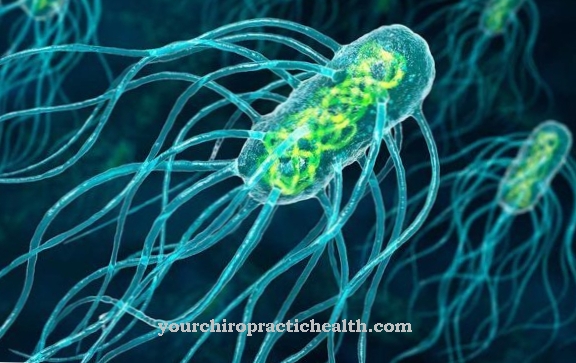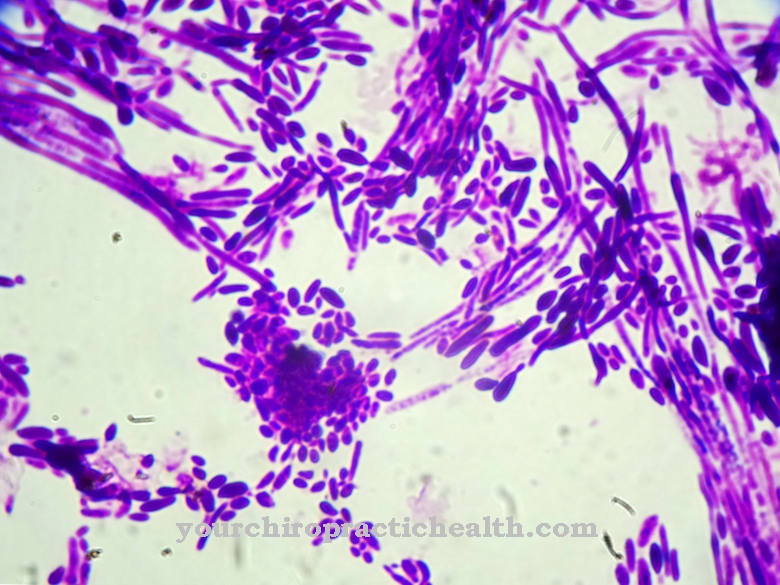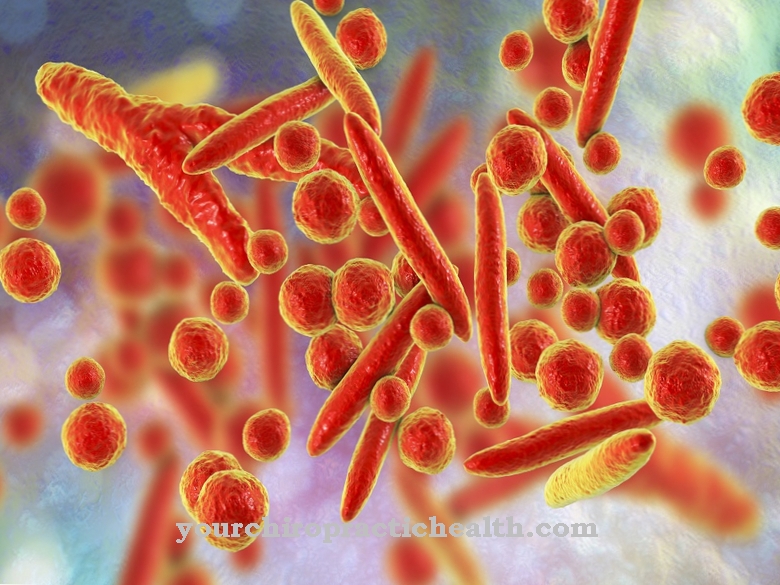Streptomyces are bacteria belonging to the Actinobacteria. They are used to produce antibiotics.
What are Streptomyces?
Streptomyces are a genus of bacteria from the order Actinomycetales and the family Streptomycetaceae. They belong to the group of gram-positive bacteria. This means that they can be colored blue in the Gram stain. In contrast to the gram-negative bacteria, the gram-positive bacteria do not have an additional outer cell membrane, but only have a thick peptidoglycan layer made of murein.
Streptomyces are aerobic bacteria. So they need oxygen to generate energy. They also belong to the mycelium-forming bacteria. Like many representatives of the Actinomycetales bacterial order, they form filaments, the mycelia. These are elongated, branched cells that form plexuses. The individual filaments have a diameter of 0.5 to 1 µm. A distinction can be made between two forms of mycelia. The substrate mycelium grows in a nutrient medium. This can be liquid or solid. The aerial mycelium grows in the gas space above the nutrient medium. Spores can develop from the mycelia. However, these are endospores that have no resemblance to the exospores that are formed by bacteria such as clostridia or Bacillus.
Occurrence, Distribution & Properties
The bacterial genus Streptomyces occurs predominantly in soils. A large number of bacteria produce fragrances when generating energy. Among them is the geosmin. Geosmin smells earthy and musty and is perceived by many people as a typical soil odor of earth or forest soil. But it is also responsible for the smell of mold. Geosmin is also involved in the formation of odors that people perceive when it rains after a long period of dryness. The Streptomyces geosmin is responsible for a multitude of familiar smells in nature.
Streptomyces are aerobic bacteria that occur in their active form mainly in soil, but also in water. Compost, for example, contains a particularly large number of streptomycetes. Streptomyces are also found in the so-called rhizosphere of plants. The rhizosphere is the space in the ground that is directly influenced by the roots of a plant. The bacteria are also found in the digestive tract of worms or arthropods.
In unfavorable environmental conditions, there are usually only inactive Streptomyces spores. These spores can survive for a very long time even in poor conditions and are used to spread the bacteria. The bacteria thrive best at 25 to 30 ° C. However, some bacteria of the genus Streptomyces are also thermophilic. They prefer temperatures between 28 and 55 ° C. Psychrophilic Streptomyces, on the other hand, like the cold. The bacteria grow optimally at a pH value between 6.5 and 8. They are therefore preferably found in pH-neutral or slightly alkaline soils. Few bacteria from the group of Streptomyces prefer acidic soils.
Meaning & function
Many of the Streptomyces species are useful to humans. They are used as antibiotic producers. For example, Streptomyces aureofaciens produce tetracycline and chlortetracycline. Tetracycline is a broad spectrum antibiotic that is used against various bacterial infections. One area of application for the antibiotic is acne. Chlortetracycline is used to treat bacterially infected wounds.
The bacterium Streptomyces fradiae produces two antibiotics at the same time. Neomycin is a broad spectrum antibiotic that works primarily against gram-positive but also against gram-negative bacteria. It blocks the protein synthesis of various bacteria so that they can no longer multiply. Neomycin is one of the bacteriostatic antibiotics. It is used in the form of sulfate salt for local infections of the skin or mucous membrane, for wounds or burns. As a sterile solution, the drug is used to treat bladder and urinary tract infections in those who wear catheters or after urological surgery.
The other antibiotic produced by Streptomyces fradiae is tylosin. Tylosin is also a bacteriostatic antibiotic. It does not kill the bacteria, but prevents them from multiplying. The antibiotic is actually only approved in veterinary medicine. However, its application in the therapy of chronic inflammatory bowel disease is currently being tested. Tylosin seems to have a positive effect on the intestinal inflammation that often occurs in Crohn's disease.
But not only drugs against bacteria are made with these bacteria. Antifungal drugs can also be made with Streptomyces bacteria. Streptomyces noursei produces the antimycotic nystatin. Nystatin is used to treat fungal infections. For example, infections with Candida albicans or Aspergillus fumigatus are treated with nystatin.
Illnesses & ailments
Certain bacteria from the genus Streptomyces can cause the potato scab in plants. Some bacteria are also dangerous to animals. In humans, Streptomyces only play a minor role as a pathogen. Most of these bacteria are not pathogenic to humans.
Streptomyces somaliensis and Streptomyces sudanensis are an exception. The pathogens cause the mycetoma. The mycetoma is also known as a fungal tumor. It is a chronic inflammatory process of the skin. The disease has a very slow course and is characterized by an increase in the volume of the affected part of the body. The foot is often affected. Numerous lumps appear. In the middle of the nodes there are fistula-like openings from which a liquid is excreted. There are small grains in this liquid. In the course of the disease, the inflammation also reaches deeper structures such as bones or meninges.


.jpg)






















.jpg)


